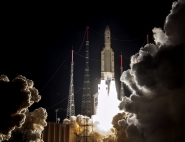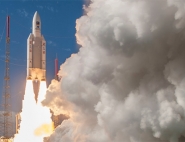CNES projects library
C
I
M
P
S
U
Ariane series
Based initially on the work of CNES, the Ariane programme was launched by the European Space Agency in 1973, to enable Europe to put its satellites into orbit without having to rely on the other space powers. It replaced the unsuccessful Europa programme, initiated in the 1960s.
The first version of Ariane, Ariane 1, made its inaugural flight from the Guiana Space Centre on 24 December 1979. It was quickly replaced by more powerful versions—Ariane 2, Ariane 3 and Ariane 4—which made their first flights in 1986, 1984 and 1988 respectively.
The increased mass of satellites then made it necessary to go back to the drawing board. This resulted in the Ariane 5 version, capable of placing up to 9.4 tonnes into geostationary transfer orbit (GTO). Following its first flight in 1996, Ariane 5 quickly became a world leader in the telecommunications satellite launch market. But the double launch capacity that was for so long one of its strengths soon became something of a challenge within an increasingly competitive context. The market was changing, and Ariane’s technical-economic model had to adapt accordingly.
So in 2014, Europe decided to breathe new life into Ariane once more, with the launch of the Ariane 6 programme. Designed by teams from CNES, the European Space Agency and industry, Ariane 6 will be better adapted to the launch of government and commercial satellites, thanks to its two versions (Ariane 61 and Ariane 64), the ability to relight its upper stage, and managed production costs. First launch could take place from the Guiana Space Centre in 2024.
Mission's news feed
-

[CNESMAG] Space transportation:the crucial connection
Our new issue is now available!
June 9, 2023
-

[REPLAY] Ariane 5 launch - BepiColombo (VA245)
Ariane 5 completes 101st successful launch. The European BepiColombo mission on its way to Mercury. Rendezvous on 5 December 2025!
October 20, 2018
-

[Replay] 4 new Galileo satellites in orbit !
Ariane 5 ES orbited four more satellites (satellites 23 to 26) for the Galileo constellation. Liftoff happened at 13:25 (Paris time).
July 25, 2018


